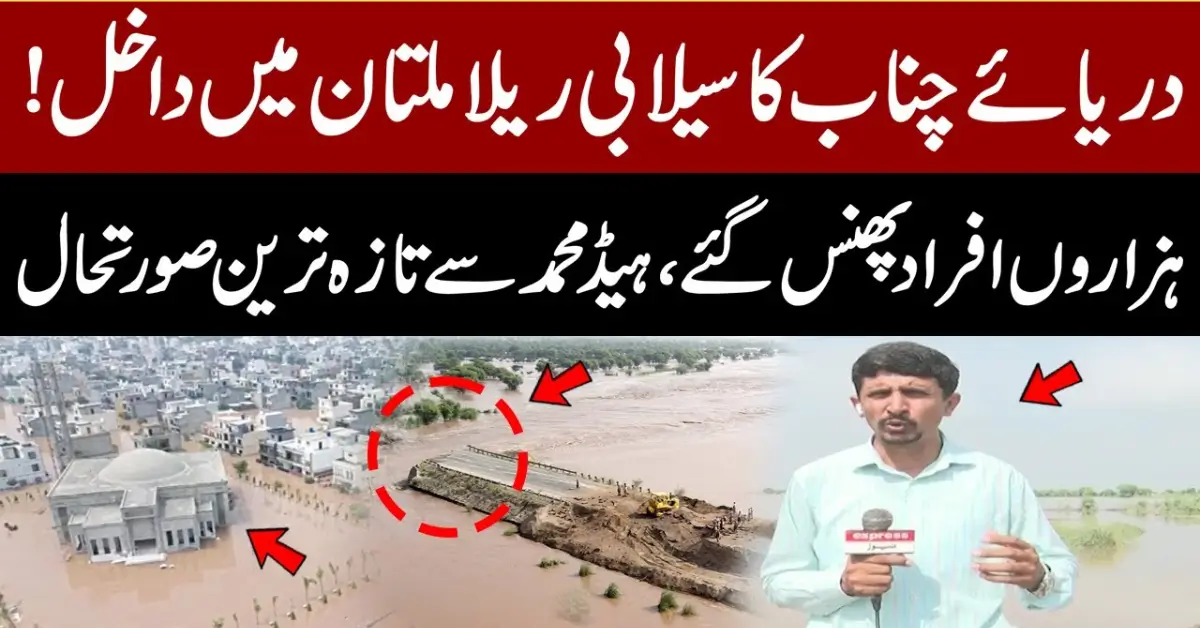Flooding of Chenab River Causes Widespread Destruction in Multan
Flooding of Chenab River Causes Widespread Destruction in Multan: The province of Punjab in Pakistan is currently facing one of the most severe flood situations in recent years. Continuous rainfall, overflowing rivers, and dam breaches have caused widespread destruction across several districts. The floods have affected thousands of people, destroyed crops on hundreds of acres, and claimed lives. Key rivers, including the Chenab, Ravi, Sutlej, and Indus, have reached dangerously high levels, putting lives and livelihoods at risk.
Chenab River Flooding: Multan and Jhang in Crisis
Floodwaters from the Chenab River have entered the limits of Multan, raising alarm among local residents and authorities. A high level of flood has also been reported at the Trimu Barrage, which is the meeting point of the Chenab and Jhelum rivers.
In a tragic incident in Jhang, a 45-year-old woman named Shahnaz Bibi, who had taken refuge at a safe location, returned to check on her home in Pakkewala village. Unfortunately, she was swept away by the strong flood currents and drowned. Her body was recovered by local villagers after 24 hours. This heartbreaking incident highlights the deadly risk posed by these floods in Punjab.
Flood Warning in Chenab River from India Rising Water Levels Trigger Alert at Tawi and Head Marala

Ravi River Overflows into Kamalia and Pirmahal
The situation is equally dire in areas near the Ravi River. After causing severe damage in Kamalia, floodwaters have now entered Pirmahal, where the water levels are reported to be extremely high. Authorities are on high alert as the Head Sadhanai point on the Ravi River is recording a very high flood level, with a water flow of 119,000 cusecs.
This sudden surge has not only damaged infrastructure but also forced hundreds of families to evacuate their homes.
Sutlej River Breach: Sayidiwala Dam Breaks in Lodhran
In Lodhran, the ongoing flood situation in the Sutlej River has resulted in the Sayidiwala dam breaking. This breach has caused floodwater to rush into nearby villages, submerging homes and vast agricultural lands.
Hundreds of acres of standing crops have been inundated, causing significant economic losses to local farmers. Around 615 people and 60 livestock were evacuated and moved to safer locations. The land connection between Sayidiwala and Jhok Imam Bakhsh has also been cut off, further complicating relief efforts.
PTA Mobile Registration for Overseas Pakistanis: 120-Day Tax-Free Connectivity Made Easy
Flash Floods in Dera Ghazi Khan
Meanwhile, in the mountainous regions of Dera Ghazi Khan, torrential rains have caused flash floods in seasonal rivers. These rain-fed rivers have increased the water flow in the Indus River, adding to the pressure downstream.
According to local administration, the water flow at Ghazi Ghat in the Indus River has reached 260,000 cusecs, marking a significant rise and posing a flood threat to nearby areas.
Response from Local Authorities
District administrations across the affected regions are working around the clock to manage the situation. Rescue teams are actively involved in relocating people and livestock to safer zones. Relief camps have been set up, and emergency services are monitoring river levels at all major barrages and control points.
Despite these efforts, the scale of the flooding and the spread across multiple districts have made response efforts extremely challenging.
Nationwide Holiday Declared on Sept 6, 2025 for Eid Milad-un-Nabi by Federal Govt
Human and Agricultural Impact
The floods in Punjab have already taken lives, like that of Shahnaz Bibi, and displaced hundreds of families. Crops on hundreds of acres have been destroyed, impacting the agricultural backbone of the region. Livestock losses, submerged homes, and damaged roads have made survival and recovery even harder for the affected communities.
The economic damage is still being assessed, but initial reports suggest that recovery will require significant resources and coordinated efforts.

